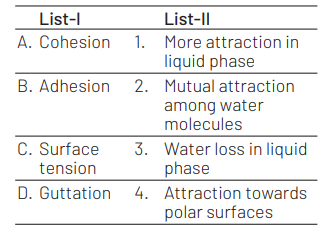Question
Match the List-I with List-II. [NEET 2021]

Choose the correct answer from the options given below.
(a) $\begin{array}{lllll}A & \mathrm{~B} & \mathrm{C} & \mathrm{D} \\ & 4 & 1 & 3\end{array}$
(b) $4 \quad 3 \quad 2 \quad 1$
(c) $3 \quad 1 \quad 4 \quad 2$
(d) $2 \quad 1 \quad 4 \quad 3$
Answer/Explanation
Ans. (a)
(A)-(2), (B)-(4), (C)-(1), (D)-(3)
Cohesion is the property of like molecules (of the same substance) to stick to each other due to mutual attraction, e.g. attraction of water molecules.
Adhesion is the property of different molecules or surfaces to cling to each other. Adhesion is the attraction of molecules of one kind for molecules of a different kind, and it can be quite strong for water, especially with other molecules bearing positive or negative charges.
At liquid-air interfaces, surface tension results from the greater attraction of liquid molecules to each other (cohesion) than to the molecules in the air (adhesion). The process by which plants loose water in liquid form usually from tips and margins of leaves is called guttation.
Question
A few drops of sap were collected by cutting across a plant stem by a suitable method. The sap was tested chemically. Which one of the following test results indicates that it is phloem sap? [NEET 2016, Phase II]
(a) Acidic
(b) Alkaline
(c) Low refractive index
(d) The absence of sugar
Answer/Explanation
Ans. (b)
The phloem sap is alkaline in nature. It continuously pumps protons from its companion cells to the other neighbouring cells during transport of sugars.
Question
Root pressure develops due to [CBSE AIPMT 2015]
(a) active absorption
(b) low osmotic potential in soil
(c) passive absorption
(d) increase in transpiration
Answer/Explanation
Ans. (a)
Root pressure is the positive pressure that develops in the roots of plants by the active absorption of nutrients from the soil. When the nutrients are actively absorbed by root hairs, water (along with minerals) increases the pressure in the xylem. This pressure pushes water up to small heights.
Question
A column of water within xylem vessels of tall trees does not break under its weight because of [CBSE AIPMT 2015]
(a) dissolved sugars in water
(b) tensile strength of water
(c) lignification of xylem vessels
(d) positive root pressure
Answer/Explanation
Ans. (b)
A column of water within xylem vessels of tall trees does not break under its weight because of high tensile strength of water, i.e. an ability to resist a pulling force. This high tensile property
Question
Meaningful girdling (ringing) experiment cannot be performed within sugarcane because [CBSE AIPMT 1992]
(a) its phloem is situated interior to xylem
(b) its stem surface is covered with waxy coating
(c) its vascular bundles are not present in a ring
(d) its stem is thin
Answer/Explanation
Ans. (c)
In ringing experiment removal of bark breaks the continuity of epidermis, cortex and phloem. It shows clearly that epidermis, cortex and phloem do not take part in transport of sap or water. In sugarcane (monocot) the vascular bundles are scattered, therefore, ringing experiment is not applicable.
Question
Guttation is caused by [CBSE AIPMT 1992]
(a) transpiration
(b) osmosis/DPD
(c) root pressure
(d) osmotic pressure
Answer/Explanation
Ans. (c)
Guttation refers to the exudation of droplets of liquid water from the margins and tip of leaves through a group of cells called hydathodes. Guttation depends on root pressure.
Question
Soil water available to roots is [CBSE AIPMT 1991]
(a) surface water
(b) hygroscopic water
(c) gravitational water
(d) capillary water
Answer/Explanation
Ans. (d)
Water, which is mainly held between the spaces of soil particles forming a septum of capillaries, is called capillary water. It is most important form of water which is mainly taken by the plants.
